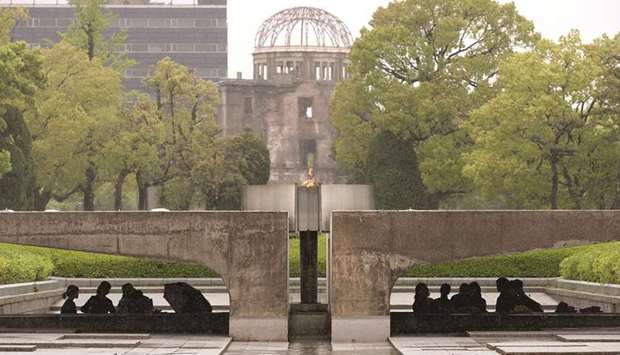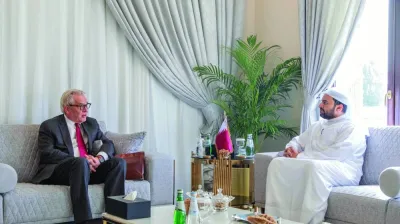Hiroshima was selected as the first target. At 8:15am on August 6, 1945, an American B-29 bomber, christened ‘Enola Gay’ (after the mother of its pilot, Colonel Paul Tibbets), dropped the first atomic bomb, ‘Little Boy.’ The explosion wiped out 90 percent of the city. And in a continued tale of horror, and just three days later, Major Charles Sweeney flew another B-29 bomber,‘Bockscar’, and dropped ‘Fat Man’ at 11:02am in Nagasaki (the initial target was the city of Kokura).
And the world changed forever.
The attacks claimed an estimated 200,000 lives almost immediately, with the death toll continued to rise over the decades due to radiation-related sickness and injuries. Buildings were incinerated; houses were gone with hundreds of people with burns, walking all around like an army of ghosts. “Water, water,” they would say. But the water was so contaminated that they would die after the first sip. The groans eventually faded as people died one after another. For many of the less fortunate, the battle continued long after the dust settled and the shattered cities were rebuilt.
At this point in time, it is a tale worth telling once again. 15,000 nuclear weapons remain stockpiled around the world, with hundreds of them prepared for launch at a moment’s notice. This week marks the 73rd anniversary of the horrific and inhumane A-bombing. It does resurrect a catalogue of painful memories, alongside a strengthened resolve to voice our opposition to nuclear warfare.
There will be numerous memorial services in addition to countless peace concerts and exhibitions. UN Secretary General Antonio Guterres will make a historical visit to Nagasaki, Hiroshima Mayor will deliver the annual ‘Peace Declaration’ in the city’s Peace Memorial Park, Yoko Ono will unveil ‘Imagine Peace Wish Tree’ campaign, plus commemorative ‘Abolish Nuclear War’ banners, floating lanterns and origami peace cranes.
It comes a little more than an year after the ‘Treaty on the Prohibition of Nuclear Weapons’ was passed with support from 122 UN members, but without backing from Japan, despite being the only nation to have suffered a wartime atomic attack, or any of the major nuclear powers that constitute the five permanent members of the UN Security Council.
Hiroshima’s Flame of Peace was lit in 1964 to honour the victims of the nuclear bombing and will be extinguished only when the nuclear threat has been completely eliminated from the face of the Earth. It’s time to extinguish it forever. It’s the time to inveigh against the insanity of mutually assured destruction.
The time starts NOW. Being at peace is the happiest and most precious thing for humankind.
Welcome to the world of ‘Nutty’s Infotainment. YAYS!’
Who are ‘hibakushas’ in Japan?
Surviving victims of Hiroshima and Nagasaki bombing.
After WWII, most of Hiroshima would be rebuilt, though one destroyed section was set aside as a reminder of the effects of the atomic bomb. Name this structure which was designated a Unesco World Heritage site in 1996.
The A-Bomb Dome
In the field of entertainment, what is an EGOT award?
EGOT is an acronym for ‘Emmy, Grammy, Oscar, Tony’ in reference to persons who have won all four awards.
What was the significance of Oleander being made the official flower of Hiroshima?
It was the first thing to bloom again after the 1945 bombing.
Who owns a company called Duchy Originals in UK?
Prince Charles.
The legend goes that Allen Lane was returning from visiting Agatha Christie in Cornwall, and ended up stuck in a railway station in Devon without anything good to read, or to purchase. He came up with an idea and, on July 30 1935, he founded something which is considered as the first mass market of a certain concept. What is it?
Penguin Books. It started revolution in paperback publishing.
The world’s longest running music show was first transmitted live from a converted church in Manchester on BBC ONE, New Year’s Day in 1964. It ran for 2,204 episodes over a period of 42 years ending in July, 2006. Name this show.
Top of the Pops, also known as TOTP
Name all Beatles who could read (and write) music?
None.
In which year was Adolf Hitler nominated for Nobel Peace Prize.
1939. It was later withdrawn.
Born this day in 1930, he took his first airplane flight at the age of 6. He earned his pilot’s license on his 16th birthday even before he received his driver’s license. Identify the boy below who made “a giant leap for mankind” shortly before his 39th birthday.
(Answer next week. Answer to last week’s photoquiz: Sirimavo Bandaranaike of Sri Lanka, then Ceylon)



